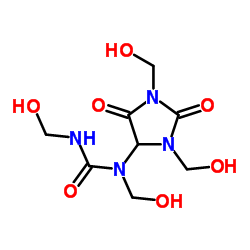78491-02-8
| Name | Diazolidinyl urea |
|---|---|
| Synonyms |
1-[1,3-Bis(hydroxymethyl)-2,5-dioxoimidazolidin-4-yl]-1,3-bis(hydroxymethyl)urea
Diazolidinylurea N-[1,3-Bis(hydroxymethyl)-2,5-dioxo-4-imidazolidinyl]-N,N'-bis(hydroxymethyl)urea Diazolidinyl urea MFCD00079129 urea, diazolidinyl EINECS 278-928-2 1-[1,3-Bis(hydroxymethyl)-2,5-dioxo-4-imidazolidinyl]-1,3-bis(hydroxymethyl)urea Urea, N-[1,3-bis(hydroxymethyl)-2,5-dioxo-4-imidazolidinyl]-N,N'-bis(hydroxymethyl)- |
| Description | Diazolidinyl urea, a broad spectrum preservative, is a formaldehyde-releasing compound that releases formaldehyde through its decomposition. Diazolidinyl urea is effective against most contaminating microorganisms, especially Pseudomonas[1][2]. |
|---|---|
| Related Catalog | |
| References |
| Density | 1.8±0.1 g/cm3 |
|---|---|
| Boiling Point | 421.04°C (rough estimate) |
| Molecular Formula | C8H14N4O7 |
| Molecular Weight | 278.219 |
| Exact Mass | 278.086243 |
| PSA | 153.88000 |
| LogP | -3.69 |
| Index of Refraction | 1.703 |
| Storage condition | 2-8°C |
| Stability | Stable. Incompatible with strong oxidizing agents. |
CHEMICAL IDENTIFICATION
HEALTH HAZARD DATAACUTE TOXICITY DATA
|
| Symbol |

GHS07 |
|---|---|
| Signal Word | Warning |
| Hazard Statements | H317 |
| Precautionary Statements | P280 |
| Personal Protective Equipment | dust mask type N95 (US);Eyeshields;Faceshields;Gloves |
| Hazard Codes | Xi:Irritant |
| Risk Phrases | R43 |
| Safety Phrases | S36/37 |
| RIDADR | NONH for all modes of transport |
| WGK Germany | 2 |
| RTECS | YS2717000 |
| HS Code | 2933990090 |
| HS Code | 2933990090 |
|---|---|
| Summary | 2933990090. heterocyclic compounds with nitrogen hetero-atom(s) only. VAT:17.0%. Tax rebate rate:13.0%. . MFN tariff:6.5%. General tariff:20.0% |

